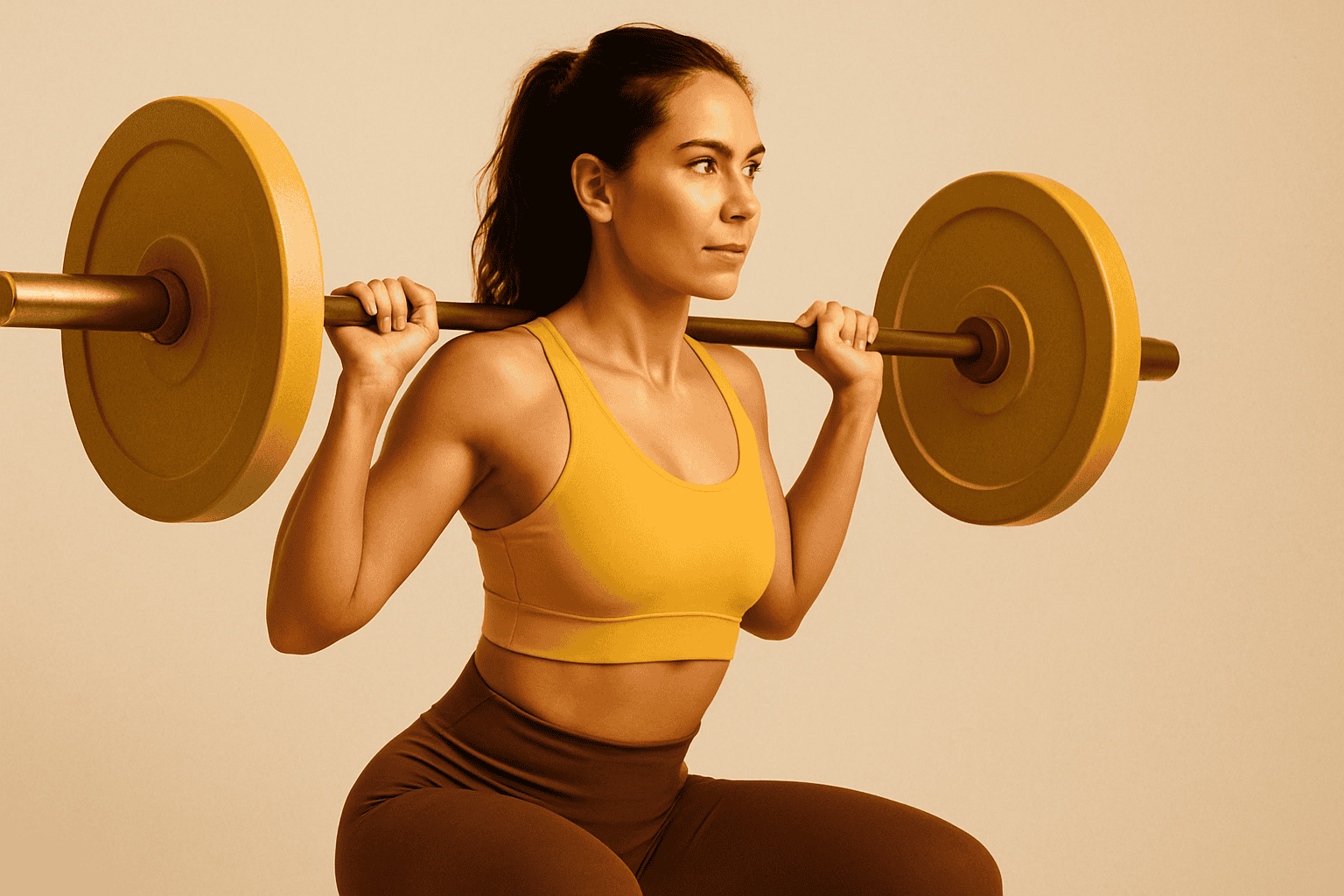Women naturally store 20–30% less creatine than men.
At 44, I’m calling this my Year of the Booty—aka time to prioritize building lean muscle mass. Creatine is on my shortlist of tools to help.
Turns out, the old-school gym bros were onto something—just not the whole story. Creatine does a lot more than fuel your workout while you pump up your biceps.
🤓 What to Know: Creatine supports your muscles, bones and brain.
After decades of yoga, I finally dropped my fear that lifting weights would make me “bulky.” Muscle isn’t about vanity—it’s about vitality.
I’m post-babies, pre-perimenopause—prime time to build lean mass before hormonal shifts make it harder (Experimental Gerontology 2021). So, I picked up weights, added a weekly HIIT class, and started researching supplements to help make my workouts more effective.
I thought creatine was only for 80s bodybuilders. But it’s become a staple in the longevity world—particularly among women—for good reason:
Muscle & Metabolic Health:
- Creatine itself doesn’t build new muscle but improves your body’s ability to perform—and recover from—strength-based exercise.
- Creatine helps rapidly regenerate ATP, the primary fuel for short, intense exercise like lifting or sprinting (Nutrients 2021).
- This means you can lift heavier, do more reps, and recover faster between sets—leading to more muscle-building stimulus over time.
Bone Health:
- Creatine supplementation is not a stand-alone “bone booster.” But again, it can support the bone building benefits of exercise.
- Paired with consistent resistance training, research shows it can preserve bone strength and structure as you age (Bone 2022).
- It might be especially beneficial for at-risk women during and after menopause (Medicine and Science in Sports and Exercise 2015) though more research is needed here.
Brain Health:
- A meta-analysis of 16 studies showed creatine can boost memory, attention, and processing speed—especially for women (Frontiers in Nutrition 2024).
- One small study even found improvements for Alzheimer’s patients (Alzheimer’s & Dementia 2025).
- A single high-dose (~25 g) of creatine can reverse fatigue-related cognitive decline when you’re sleep-deprived (Nature 2024), which makes sense given how many reports I’m hearing that creatine is helping people find jetlag relief this summer.
And yes, it’s safe. A review of nearly 700 studies found no significant side effects compared to placebo (Journal of the International Society of Sports Nutrition 2025). Some people get mild GI upset or cramps, but it’s rare.
💪 What to Do: Take 3-5g creatine daily.
How much: 3–5g daily of creatine monohydrate or creatine HCL. I take 5g of creatine monohydrate. I don’t experience any bloating or GI side effects but if you do, try dropping down to 3g or switching to HCL.
When: Anytime works—consistency matters most (Frontiers 2022). I add mine to my morning smoothie.
Avoid:
- ❌ Creatine Ethyl Ester (CEE)—less effective and breaks down faster.
- ❌ Premixed liquids—unstable in liquid form and quickly breaks down into ineffective creatinine. Plus, liquids often contains additives or fillers.
- ⚪ Lipsomal creatine—a newer form of creatine encapsulated in fat-based liposomes to enhance absorption and reduce breakdown. It’s more expensive and lacks the decades of research supporting creatine monohydrate.
Do I need to “load” it?
Optional. You can do 20g/day (split into 4 doses) for 5–7 days to saturate muscles faster, then switch to a 3–5g daily maintenance dose. But you’ll still see benefits without it—and bloating is more likely with loading.
⚡ Lightning Round
- My Favorite Creatine
I like Thorne’s creatine monohydrate, but I’ve also been using my friend JJ Virgin’s SHEatine supplement which is creatine HCL, a more water-soluble form of creatine that’s less likely to cause GI issues.
Both work for me and I don’t have any negative symptoms with either. See what works best for your body.
🛒 Try the capsule form if you want to avoid the giant tub on your counter
- Lower your risk of ovarian cancer by 50%
Tubal ligation (“getting your tubes tied”) is still the most common permanent birth control for women (CDC 2020).
Data shows removing the fallopian tubes (salpingectomy) instead of tying them can cut your ovarian cancer risk in half (Obstetrics & Gynecology 2022).
🔎 I’m sharing this article with every patient done having kids—please share it with a friend who should know, too!
- Listen In: My Brains, Bones & Booty Protocol
I joined Dr. Stephen Gundry’s podcast to break down my full BBB protocol. i.e. how we protect cognitive health, bone density, and muscle strength through midlife and beyond.
We also tackled why HRT is still wildly under-prescribed and how to know if your wearable is giving you accurate sleep data.
🎧 Listen for more on the protocols we prescribe for HRT and our take on which wearable is actually right.
💛 The Momgevity Files
I’m writing you a prescription for a detox—from life.
This week, every mom friend and patient I know is saying the same thing: I’m done. Yoga, ashwagandha, breathing apps? Cute, but not cutting it. They want something stronger—like a Valium.
I feel it too. The collective anxiety is brutal. The news out of Texas? It’s absolutely gutting as a parent to watch. Add the endless doom-scroll, end-of-school chaos, work, family—too many threads to hold. When I’m this spun up, my nervous system waves the white flag.
So here’s my radical move: I’m taking my two-week summer break and actually stopping. No “one more call.” No micromanaging camp schedules that are already managed by someone else. No headline rabbit holes.
Think of it as a life detox. Like hot sauna/cold plunge resets your body, unplugging resets your brain. We need valleys, not just peaks. Stay stuck on “go” too long and your stress system fries.
So here’s your nudge: If you’re craving a Valium, maybe you really need a world-off switch. Drop the threads. Find your quiet valley.
And if you must do something? Here’s how you can help the families of the victims of the Texas floods this week.
Stay strong, stay curious—and don’t forget to breathe.
Robin
